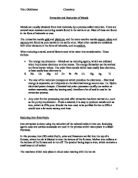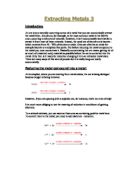The formula of a molecule shows the number of atoms in the molecule; for example, H2O shows that a water molecule contains two hydrogen atoms and one oxygen atom.
Chemical Equations
Atoms get re-arranged in chemical reactions.
The mass of the products is equal to the mass of the reactants.
Symbol equations should always be balanced.
C1 1.2 – Rocks & Building Materials
Limestone and its uses
Limestone is made mainly of calcium carbonate, CaCO3.
Limestone is used as a building material and to make calcium oxide and cement.
Cement mixed with sand, aggregate and water makes concrete.
Calcium carbonate (CaCO3) decomposes when heated to make calcium oxide (CaO) and carbon dioxide (CO2) – this type of reaction is called thermal decomposition, and is done on a large scale, in lime kilns.
Reactions of carbonates
Metal carbonates decompose when heated to produce the metal oxide and carbon dioxide.
Carbonates react with acids to produce a salt, water and carbon dioxide.
Limewater is used to test for carbon dioxide because carbon dioxide turns limewater cloudy.
‘The Limestone Reaction Cycle’
Thermal decomposition of calcium carbonate produces calcium oxide and carbon dioxide.
Calcium oxide reacts with water to produce calcium hydroxide.
Calcium hydroxide is an alkali that can be used to neutralise acids.
Calcium hydroxide reacts with carbon dioxide to produce calcium carbonate.
Cement and Concrete
Cement is made by heating limestone with clay in a kiln.
Mortar is made by mixing cement and sand with water.
Concrete is made by mixing aggregate with cement, sand and water.
Limestone Issues
There are good and bad points about quarrying for limestone.
Limestone, cement and concrete are needed as building materials.
Quarrying and processing limestone and its products have negative impacts on the environment.
C1 1.3 - Metals and their uses
Extracting Metals
Metals are usually found in the Earth’s crust. They are combined chemically with other elements such as oxygen.
An ore contains enough metal to make it worth extracting the metal.
The method we use to extract a metal depends on its reactivity.
Unreactive metals are found in the Earth as the metal.
The oxides of metals less reactive than carbon can be reduced using carbon.
Irons and Steels
Iron oxide is reduced in a blast furnace to make iron.
Iron from the blast furnace is too brittle and hard and so it only has few uses as cast iron.
Most iron is converted into alloys called steels.
Steels contain carefully controlled quantities of carbon and other elements.
Aluminium and Titanium
Aluminium and titanium resist corrosion. They also have low densities compared with other strong metals.
Aluminium and titanium cannot be extracted from their oxides using carbon.
Aluminium and titanium are expensive because extracting them involves many stages and requires large amounts of energy.
Aluminium is more reactive than carbon and so its oxide cannot be reduced using carbon. Instead, it has to be extracted by electrolysis of molten aluminium oxide; this process requires high temperatures and uses a lot of electricity, this makes aluminium expensive to extract.
Pure aluminium is not very strong but aluminium alloys are stronger and harder – they have many uses.
Titanium is resistant to corrosion and is very strong. It has a low density compared with other strong metals.
Titanium, unlike aluminium, can be reduced by carbon, but the metal reacts with the carbon making it brittle.
Titanium is extracted from its ore by a process that involves several stages and large amounts of energy. The high costs of this particular process mean titanium is expensive to buy.
Extracting Copper
Most copper is extracted from copper-rich ores by smelting. This means heating the ore strongly in a furnace.
As smelting produces impure copper, the copper can be purified by a process called electrolysis. Both smelting a purifying copper require lots of heating and electricity.
Copper rich ores are a limited resource but scientists are developing ways to extract copper from low-grade ores.
Bioleaching and phytomining are new ways to extract copper from low-grade ores.
Bioleaching uses bacteria to produce solutions containing copper compounds.
Phytomining uses plants to absorb copper compounds from the ground. The plants are then burned to produce ash from which copper can be extracted.
Copper can be obtained from solutions of copper salts by displacement or electrolysis.
Solutions of copper compounds can be reacted with a metal that is more reactive than copper to displace the copper.
Useful Metals
Elements from the central block of the periodic table are known as the transition metals. They are all metals that have similar properties; they are all good conductors of heat and electricity. Many of the metals from this particular section are strong, but are able to be bent or hammered into shape. These properties make them useful as materials for building, vehicles, containers, pipes and wires.
Copper is another well-known useful metal; it is a very good conductor of heat and does not react with water. It can be bent but it is hard enough to keep its shape. All of these properties make it useful for making pipes and tanks in water and heating systems. It is a very good conductor of electricity as well, and so is used for electrical wiring.
Most of the metals we use are alloys because they are stronger; some metals in their pure form are soft and easily bent.
Metallic Issues
Mining for metal ores involves digging up and processing large amounts of rock. Not only can this produce large amounts of waste material, but it can affect large areas of the environment.
Recycling metals saves the energy needed to extract the metal. Recycling saves resources because less ore needs to be mined. Also








